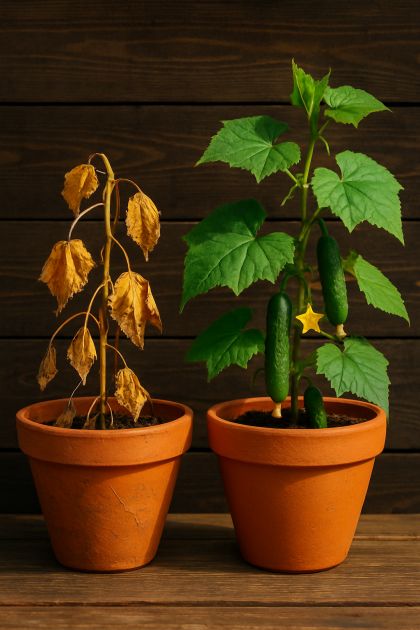Gardening can be a therapeutic and rewarding hobby, but it can also come with its fair share of challenges. One of the most common issues that gardeners face, especially those growing cucumbers, is the yellowing of leaves. This can be a frustrating experience, particularly when you’ve invested time and effort into nurturing your plants.
Many gardeners might immediately blame themselves or assume that their plants are beyond saving. However, yellowing leaves are often just a symptom of a larger, fixable issue. Understanding the root causes of this problem and knowing how to address them can drastically improve your cucumber crop. In this article, we’ll explore why cucumber plants often turn yellow and how you can prevent it with some simple and effective hacks.
Advertisement
1. Understanding the Basics of Cucumber Plant Growth
Cucumbers are warm-season plants that thrive when conditions are just right. They require full sun, which means at least 6 to 8 hours of direct sunlight per day. They also prefer well-drained soil with a pH between 6.0 and 7.0. Cucumbers can be either vining or bush types, and each has its unique space and support needs.
Knowing these basics helps set a solid foundation for healthy cucumber plants. When planting, ensure you space them adequately—about 36 to 60 inches apart for vining types—to allow for proper air circulation and growth. This helps to prevent common diseases that can cause yellowing.
2. Common Causes of Yellowing Leaves
Yellowing leaves, or chlorosis, can result from several factors. One of the most common causes is a deficiency in essential nutrients such as nitrogen, potassium, or magnesium. When plants lack these nutrients, they cannot produce enough chlorophyll, leading to yellowing.
Another common cause is overwatering or poor drainage. Cucumber roots need oxygen to thrive, and waterlogged soil can suffocate them. Additionally, diseases such as powdery mildew or pests like spider mites can also lead to yellow leaves.
3. The Role of Soil Quality and Nutrients
Healthy soil is crucial for plant growth, as it provides the necessary nutrients and a stable environment for roots. Conduct a soil test before planting to check for nutrient deficiencies. Amend the soil with compost or well-rotted manure to enhance its nutrient content.
Fertilizers can also be used to correct specific nutrient deficiencies. For instance, if your soil lacks nitrogen, a balanced fertilizer with a higher nitrogen content can help, while Epsom salt can address magnesium deficiencies.
4. Impact of Watering Practices
Proper watering is essential for cucumber plants. They require about 1 to 2 inches of water per week, and it’s better to water deeply and less frequently rather than shallow and often. This encourages roots to grow deeper and more robust.
Avoid overhead watering, which can promote fungal diseases. Instead, water at the base of the plant early in the morning to allow foliage to dry throughout the day, reducing the risk of disease.
5. How Sunlight Affects Cucumber Plants
Sunlight is a critical factor for cucumber plants. Insufficient sunlight can lead to weak, spindly growth and yellowing leaves. Ensure your cucumbers receive at least 6 to 8 hours of direct sunlight daily. If your garden area is shady, consider moving your cucumbers to a sunnier spot or using reflective surfaces to increase light exposure.
6. The Problem with Overcrowding
Overcrowding is a common mistake that can lead to yellow leaves due to poor air circulation and competition for nutrients and water. Ensure proper spacing when planting and consider trellising vining varieties to improve air circulation and sunlight exposure.
Regularly prune excess leaves and shoots to maintain airflow and remove any diseased or damaged foliage immediately to prevent the spread of pathogens.
7. Dealing with Pests and Diseases
Cucumber plants are susceptible to pests like aphids, cucumber beetles, and spider mites, all of which can cause yellowing. Regularly inspect your plants for signs of pests and use natural remedies like neem oil or insecticidal soap to control infestations.
Diseases such as powdery mildew and downy mildew can also cause yellow leaves. Plant disease-resistant varieties when possible and rotate crops each year to prevent disease buildup in the soil.
8. The Importance of Temperature Control
Cucumbers thrive in warm temperatures between 70°F and 95°F (21°C to 35°C). Temperatures consistently above or below this range can stress plants and lead to yellowing leaves. Use row covers or cloches to protect plants from cold spells and provide shade during extreme heat.
Be mindful of nighttime temperatures as well, as temperatures below 50°F (10°C) can slow growth and cause leaves to yellow.
9. Viral Hacks: The Banana Peel Trick
Banana peels are rich in potassium, an essential nutrient for cucumbers. Burying a banana peel near the base of your cucumber plant can provide a slow-release source of potassium, helping to prevent yellowing leaves.
Use this hack sparingly and ensure the peels are buried deep enough to avoid attracting pests. Combine this with other nutrient amendments for balanced plant nutrition.
10. Viral Hacks: Epsom Salt Solution
Epsom salt is a popular gardening hack for providing magnesium, which is crucial for chlorophyll production. Dissolve 1 tablespoon of Epsom salt in a gallon of water and use it to water your cucumber plants every four weeks.
This solution can help address magnesium deficiencies, but be cautious not to overuse it, as excess salts can lead to other nutrient imbalances.
11. Viral Hacks: Coffee Grounds for Healthier Plants
Coffee grounds are a great source of nitrogen and can help improve soil structure. Sprinkle used coffee grounds around the base of your cucumber plants to provide a slow-release nitrogen source.
Advertisement
Be careful not to overapply, as too much nitrogen can lead to excessive foliage growth at the expense of fruit production. Mix the grounds into the soil or compost them first for best results.

